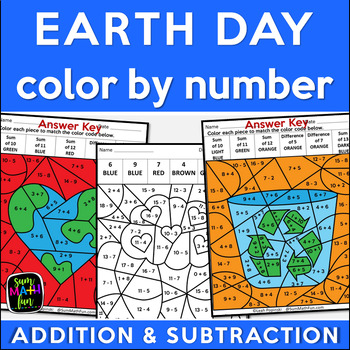Earth Day Coloring Pages Addition & Subtraction Within 20 Color by Number Code
- PDF
- Easel Activity
Also included in
- Do you need an engaging way to develop fact fluency? Kids beg to do these addition and subtraction within 20 color-by-number worksheets that include Easter, and Earth Day activities. Plus, they are NO PREP for you?!It can be a real struggle to keep kids practicing their addition and subtraction withPrice $21.88Original Price $32.75Save $10.87
Description
Wishing you had some fun spring math activities to celebrate Earth Day and Arbor Day? Students beg to do more of these Earth Day coloring pages. They don't even realize that these Spring activities are helping them gain fluency with their addition and subtraction facts within 20!
These fun addition and subtraction Earth Day color-by-number activities will have your students excited to review their facts!
The color-by-number activities are NO PREP! Just print and use it!
They will give your students a fun way to review addition and subtraction and give you an easy way to engage your students. They are designed to support students as they practice addition and subtraction facts within 20.
As students color the spaces, they are required to solve math facts over and over helping them commit these facts to memory and develop instant recall.
While your students will love coloring, they will also be reviewing and committing important math facts to memory by solving each equation and coloring the correct spaces.
There are 5 color by number worksheets in this packet that will keep your students engaged and challenged. Each math worksheet is Earth Day themed and reviews facts within 20.
❤️ Answer keys are included!
❤️ No Prep! Just Print and Go
♻️ The Earth Day coloring pages include:
• Tree - Mixed addition and subtraction within 18
• Earth - Sums of 10, 11, 12, 13 and differences of 5 and 7
• Flowers in Flower Pot - Sums of 10, 11, 12, 13 and differences of 5, 6, and 7
• Heart-Shaped Earth - Sums of 10, 11, 12 and differences of 5 and 7
• Recycling Container - Sums of 10, 11, 12, 13 and differences of 5 and 7
♻️ Computation Skills Reviewed In This Packet Are:
• Addition Facts Within 20
• Subtraction Facts Within 20
The finished pictures make a great wall or bulletin board display!
Thanks for taking the time to peek inside this resource! :)
Have fun Mathing!
-Leah







